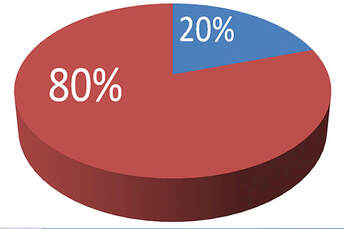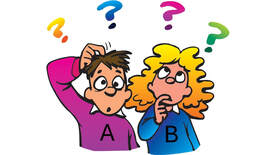 I read a post in a writers’ group on Facebook recently that said that the author had done their “research” and come to the conclusion that there were just two approaches to marketing a book. Approach One was to plug your book relentlessly on social media. Approach Two was to make sure you get your keywords right, a good cover, a snappy title and a top notch blurb so that your book would show up in searches and sell that way. The person who made the post had decided he was going to put all his eggs in one basket and just pursue one of those approaches. I’ll not say which in case it influences you to do the same, which is not the objective of this blog. In fact, the objective is exactly the opposite.  Like this shape, Marketing is multifaceted. Like this shape, Marketing is multifaceted. I’m not going to say that either of those two approaches are wrong in themselves. What I will say is that narrowing things down to just one of two approaches is like saying there are only 2 ways to cook eggs (I can think of 6 without breaking sweat). Marketing, like any discipline, is multi-faceted. Tossing a coin and saying that only one option will be taken is like taking a binary view of any activity. It rules out more than it includes and what it rules out is valuable. Good marketing is analogue decision making, not binary. Using social media to plug a book is important to an Indie author. First of all, it is all some authors can afford because everyone can afford free. Secondly it raises the author’s profile, even if it is only amongst a limited size group of people. Finally, it can actually sell books if done the right way. But having the right keywords, cover, blurb etc is also essential. Keywords get the book found in searches. But they don’t sell the book. Once the book has been found, the cover attracts attention, the blurb increases the reader’s curiosity, and the sale is around 70% made.  But it is either the reviews or the free sample (sometimes both) that actually sells the book. Reviews because people will buy what other people have liked and the free sample because it allows the reader to decide if the book lives up to the expectations raised by the blurb and the cover. But that assumes that the book appears high enough up in the search results. There can be no doubt that Amazon ranks search results by popularity. At the top of Page 1 of the results is always the “sponsored” books, the ones that authors or publishers have paid to be there. Then you usually get the best-sellers in the genre because Amazon knows that they are money makers. The rest of the results can be spread over many pages and there is no way of knowing how far readers will go through the results before they buy their next read. Yes, your book will be there if you used the right keywords, but they may be on page 100.  I suspect it’s going to be one of those 80:20 things. 80% of all books that will be purchased will appear on the first 2 or 3 pages of results and only the remaining 20% of sales will be made on subsequent pages of results, with the percentage declining the further you go through the pages. I have no evidence to support that, BTW, but intuitively it would seem to make sense. So, if you want to be in that 80% you have to do something else to make that happen. And that falls outside the second approach described above. To get your book into the 80% you have to find some way of marketing the book that doesn’t depend just on search results. You have to find a way of getting the reader to go looking for that book specifically, rather than doing a search. And that means finding a way of getting the reader to click on a link so that they go to exactly the right page for the book.  So, we’re back to social media. Yes and no. Social media is just one route that can be taken. We’ve already mentioned paid advertising as a way for readers to find a book the reader didn’t even know they wanted to buy. We use it and it pays for itself many times over. But for people who have a more limited budget that isn’t always a viable route to take (but check it out because it’s probably cheaper than you think). When you use social media and search results together, you start to harness the best of both worlds. It isn’t an either/or situation. It is a “both in the right place” situation. Then you can add in things such as email lists, promos, blogs and so much more.  I could list all the approaches that we at Selfishgenie Publishing use, but you would end up reading all day and you probably aren’t up for that. Scroll down to read the blog we posted a fortnight ago, because that says a bit more about what successful book marketing involves. Suffice to say – there is more than one way to skin a cat and using several ways, at the right time and in the right way, is always going to produce better results than just limiting yourself to one approach (apologies to animal lovers, but it’s just a saying. No animals were harmed in the writing of this blog). That is why marketing is such a time consuming activity for the Indie author and if you aren’t prepared to commit the time, you are always going to get disappointing levels of sales. One of the most frequent questions Indie authors ask about marketing their books is “Which is the best place to market my book?” The answer to that is so subjective that there simply is no answer.  Just because Author A had huge success using Platform X, it doesn’t mean that Author B will have the same success if they also use it. This is why you have to know your readers, especially when it comes to using social media. For example, TikTok is used a lot by younger people. Now, don’t get the idea that it is only used by them, because older people use to too. But if you want to reach younger readers, then you are better off using TikTok than using, say, Facebook. Many women find X (formerly Twitter) too hostile for them, so if you want to reach a female audience you would be better off using Instagram or perhaps Pinterest, where more women tend to hang out. And that is why Author A may be having more success and why Author B won’t because their readership is different and therefore their readers’ social media habits are different.  There are even some readers who don’t use social media at all, or the internet for that matter (I know, weird, huh?) so reaching that group of people is going to be really hard, which is where book fairs and other real world forums fit into the equation. I’m not saying you have to be everywhere, all the time. You would have to be superhuman to do that. But you do have to think in terms of being in more than one place at any time. This is why real research is so important. You have to know where the majority of your target readership hangs out and when they hang out there, so that you can be in the same place at the same time. For example, there is little point in targeting YA audiences between 9 in the morning and 4 in the afternoon, because they will be in school or college. You have to target them in the evening. So, what would we like you to take away from this blog? 1. Book marketing is not a binary choice. It is multifaceted. 2. Taking multiple approaches to marketing covers more bases, which means it is likely that you will sell more books. 3. Know where (and when) to find your readers, so your readers can find you. If you have enjoyed this blog, or found it informative, then make sure you don’t miss future editions. Just click on the button below to sign up for our newsletter. We’ll even send you a free ebook for doing so.
0 Comments
Leave a Reply. |
AuthorThis blog is compiled and curated by the Selfishgenie publishing team. Archives
June 2025
|
 RSS Feed
RSS Feed